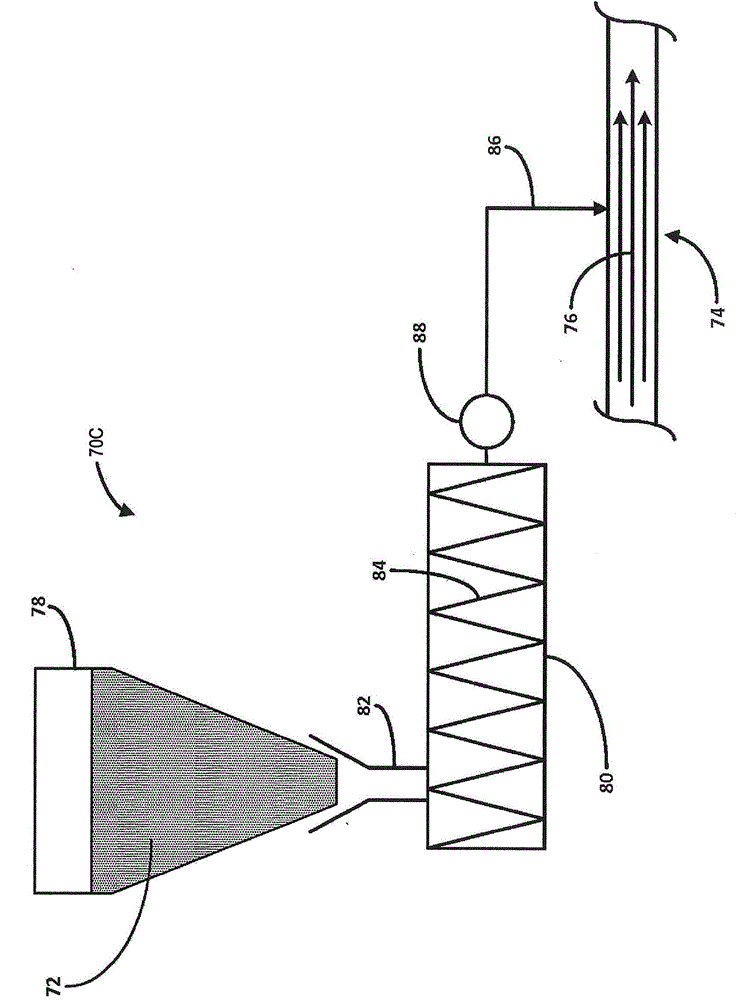Addition of copper to transfer line in nylon synthesis
A technology for feeding pipelines and copper compounds, which is applied in the field of polyamide preparation systems, and can solve problems such as reducing the quality of polyamide products and hindering the flow of polyamide
- Summary
- Abstract
- Description
- Claims
- Application Information
AI Technical Summary
Problems solved by technology
Method used
Image
Examples
Embodiment
[0074] Embodiments of the present invention may be better understood with reference to the following examples, provided by way of illustration. The invention is not limited to the examples given herein.
[0075] General System for the Examples
[0076] In the continuous nylon 6,6 manufacturing process, adipic acid and hexamethylenediamine are mixed in water in approximately equimolar ratios to form an aqueous mixture containing the nylon 6,6 salt and having about 50% water by weight. The brine solution was delivered to the evaporator at approximately 105 L / min. The evaporator heats the brine solution to about 125-135°C (130°C) and removes water from the heated brine solution such that the water concentration is about 30% by weight. The evaporated salt mixture was transferred to the tubular reactor at approximately 75 L / min. The reactor raises the temperature of the evaporated salt mixture to about 218-250°C (235°C), thereby allowing the reactor to further remove water from ...
Embodiment 2
[0093] Example 2 - Addition of copper acetate additive between flasher and finisher
[0094] A mixture of nylon 6, 6, and 5 weight percent copper(II) acetate was added to the nylon polymer mixture in the transfer line between the polymerization reactor and the flasher, downstream of the flasher, and upstream of the finisher. The mixture was preheated to about 280°C prior to addition, and added at about 2.1 L / h.
[0095]The addition of copper acetate to the line after the flasher avoids copper plating in the flasher. Because the copper does not plate out in the flasher, the flasher has an operating time of about 36 months. Due to the longer run time, the system is built using only a single flasher, and the downtime of the single flasher is tolerable. The cleaning procedure for the flasher does not require treatment for the removal of copper plating. Lower pressure conditions in the finisher resulted in less plating out of copper metal compared to Comparative Example 1a, with...
Embodiment 3
[0096] Example 3a - Addition of copper acetate additive to the transfer line downstream of the finisher.
[0097] A mixture of nylon 6, 6 and 5% by weight copper(II) acetate was added to the transfer line between the polymerization reactor and the flasher, downstream of the flasher and finisher, and upstream of the extruder. Nylon polymer blend. The mixture was preheated to about 280°C prior to addition, and added at about 2.1 L / h.
[0098] As in Example 2, the copper did not plate out in the flasher, allowing the flasher to have an operating time of approximately 36 months between maintenance and cleaning. As in Example 2, the maintenance / cleaning interval of the flasher was tolerable such that the system was built with only a single flasher. No procedure for copper removal is required when the flasher and finisher are taken offline for maintenance and cleaning.
[0099] The conditions in the transfer line resulted in very little plating of the copper metal in the transfer...
PUM
| Property | Measurement | Unit |
|---|---|---|
| density | aaaaa | aaaaa |
Abstract
Description
Claims
Application Information
 Login to view more
Login to view more - R&D Engineer
- R&D Manager
- IP Professional
- Industry Leading Data Capabilities
- Powerful AI technology
- Patent DNA Extraction
Browse by: Latest US Patents, China's latest patents, Technical Efficacy Thesaurus, Application Domain, Technology Topic.
© 2024 PatSnap. All rights reserved.Legal|Privacy policy|Modern Slavery Act Transparency Statement|Sitemap


